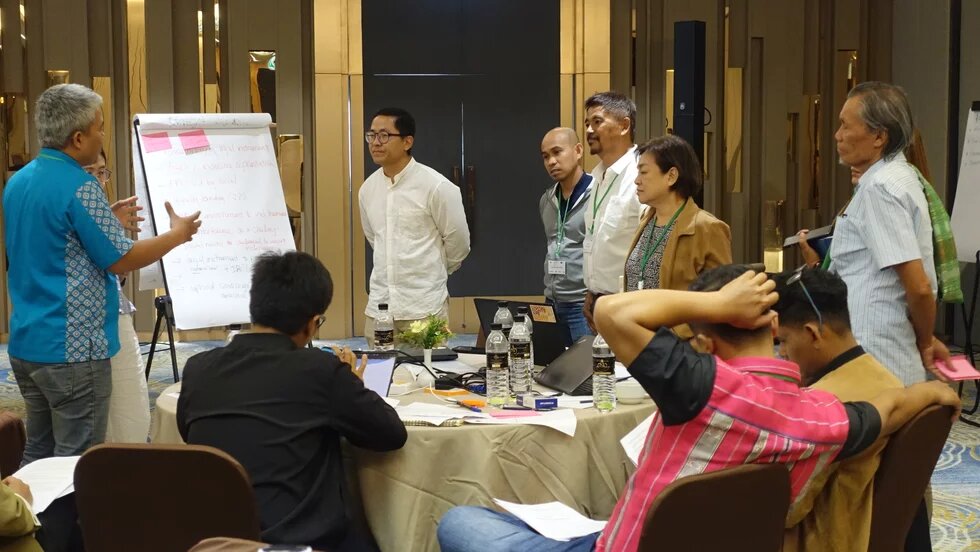
Indigenous Peoples face huge challenges in participating in official decision-making processes. This piece explores how the ASEAN Declaration on Environmental Rights has provided few opportunities for Indigenous Peoples to fully and meaningfully engage with the first-ever regional instrument that brings together human rights and the environment in Southeast Asia.

April marks the beginning of a new year for several countries in the Mekong region. This year, amidst traditional celebrations, a gathering diverged from the customary festivities. In Chiang Mai, Thailand, 37 representatives of Indigenous Peoples’ organizations and partners in the region came together to deliberate on the draft text of the ASEAN Declaration on Environmental Rights.
The meeting’s timing during national holidays was neither ideal nor intentional for the organizers and participants. Rather, it reflects the reality that Indigenous Peoples face in participating in the decision-making process: a lack of opportunities to fully and meaningfully engage with accessible information, adequate time and resources.
Glaring oversight in a historic policy
Started in 2022, the development of the Declaration, led by the ASEAN Environmental Rights Working Group, marks a significant moment in ASEAN. It would be the first-ever regional instrument that brings together human rights and the environment in Southeast Asia.
The declaration offers guiding principles for ASEAN Member States to respect, promote, protect, and fulfill substantive and procedural environmental human rights. This marks historic progress for the region in the context of severe environmental degradation and climate change impacts, coupled with a shrinking civic spacewhere environmental defenders are subject to various forms of violence, including killings and criminalization.
Yet, it is marred by a glaring absence: the underrepresentation of Indigenous Peoples.
Indigenous Peoples are missing from the Working Group, which comprises government and intergovernmental representatives, such as those from the ASEAN Intergovernmental Commission on Human Rights (AICHR), international agencies like the UN, and civil society, including youth, disability, and environmental defenders’ representatives.
On 29 March 2024, the Working Group made public a draft of the Declaration for the first time, along with a channel for stakeholders to submit inputs by 30 April 2024. This meant that, to learn about the Declaration development process, comprehend the text, and provide comments and feedback, anyone would have just one month.
For people whose first language is not English, whose background is not related to laws and policies, who live in remote places with limited access to information, but who nonetheless are protectors of the planet and bearers of the burdens of environmental degradation – like many Indigenous Peoples in Southeast Asia – a one-month period to review and contribute to such an important policy is not enough.
Ironically, the draft Declaration states, “everyone has the right to participate in decision-making in environmental matters. The right to participate should be safe, meaningful, effective and at the earliest possible stage before decisions are taken and while options are still open to the preparation of decisions,” and ASEAN Member States should “prepare special measures and procedures for people in vulnerable situations to ensure meaningful participation from them.”
Indigenous Peoples’ rights at the heart of the matter
At the Chiang Mai meeting, Indigenous Peoples pointed out a fundamental injustice at the heart of the matter: the failure to acknowledge and uphold the rights of Indigenous Peoples. Participants called for strengthened commitments of ASEAN Member States to secure environmental rights in the region. They highlighted conservation, tourism, deforestation, extractive industries, and energy projects that result in environmental degradation and development aggression, posing critical threats to Indigenous Peoples.
To make a clear position, the workshop participants released a collective statement on their non-negotiable demands to the Working Group. The statement urges the Working Group to recognize and respect Indigenous Peoples’ rights and use of the term “Indigenous Peoples” explicitly in line with international policies. Currently, it is mentioned just one time in brackets and diluted through the terms “ethnic communities”.
Environmental rights cannot be respected, protected, promoted, and fulfilled without recognizing and securing the rights of Indigenous Peoples [...] We, Indigenous Peoples, are rights holders and should be part of the decision-making process. We are very disappointed that [the Working Group] has ignored the inclusion of representative organizations of Indigenous Peoples in drafting the [Declaration]. - Indigenous Peoples' statement to the Working Group
Non-negotiable demands include also the recognition and protection of Indigenous People’s right to land, territories and resources; the right to Free, Prior and Informed Consent; and right to maintain, control, protect and develop cultural heritage, knowledge and practices; and the full protection of Environmental Human Rights Defenders (EHRDs) including Indigenous EHRDs and Indigenous Women EHRDs.
Whose rights and what rights? An opportunity for the ASEAN region
Indigenous peoples have been guardians of the planet, protecting the ecosystem and promoting biodiversity, long before the establishment of any modern-day states that are members of ASEAN. They are the champions of environmental rights, who mainstream media often portrays as “vulnerable”.
Indigenous Peoples are only made vulnerable by so-called “development” or environmental and climate projects that dispossess them of their land and territories and violate their rights. Such activities prevent Indigenous Peoples from practicing their traditional ways of living in harmony with nature.
As a result of sustained and steady advocacy efforts and solidarity at multiple scales, the rights of Indigenous Peoples and the importance of Indigenous knowledge, technology and practices are now recognized and protected by global policy instruments, such as the Paris Agreement and most recently the historic Kunming-Montreal Global Biodiversity Framework.
The Declaration is thus an opportunity for ASEAN to position itself as a leader in promoting and implementing environmental rights by attending to Indigenous Peoples’ voices. As summed up by a participant at the workshop’s final reflection, “while we are discussing high-level policies, we have to remember that the struggle is on the ground. The heroes are on the ground.” Unless and until Indigenous Peoples’ rights are fully recognized, protected, and fulfilled, environmental sustainability and climate justice remain out of reach for all.
__
Minh Tran is Research Fellow at Stockholm Environment Institute (SEI) Asia
Dayoon Kim is Research Associate at Stockholm Environment Institute (SEI) Asia
This piece is a reflection from a workshop co-organized by the Stockholm Environment Institute, Asia Indigenous Peoples’ Pact, Heinrich Boll Stiftung, the Sadhana Institute, and USAID-WWF Mekong for the Future. It reflects the views of the authors only.
This article was first published on 14 May 2024 by SEI. Republished with permission.